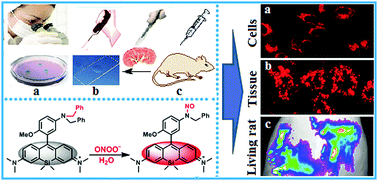A Si-rhodamine-based near-infrared fluorescent probe for visualizing endogenous peroxynitrite in living cells, tissues, and animals†‡
Abstract
Peroxynitrite (ONOO−) is an extremely powerful biological oxidant and it can react with a wide variety of molecular targets to result in a series of disease states, which has made ONOO− a central biological pathogenic factor. In order to disclose its various pathological events, a large number of fluorescent ONOO− probes have been developed in recent years. Nevertheless, some limitations still remain, such as short excitation and emission wavelengths, long fluorescence response times, and cross-interference caused by other reactive oxygen species (ROS). In this work, a new near-infrared (NIR) fluorescent probe, SiRTA, containing an aromatic tertiary amine functional group and a Si-rhodamine fluorophore, was developed for endogenous ONOO− detection and imaging. The probe exhibits not only a fast, sensitive, and specific fluorescence off–on response toward ONOO− in chemical systems but also excellent imaging ability for endogenous ONOO− in living cells. With the probe, the therapeutic effects of phenolic acid antioxidants in EA.hy926 endothelial cells suffering from ischemia–reperfusion injury and the pathogenesis of diabetes and diabetic nephropathy in pancreatic β-cells and diabetic rats have successfully been evaluated. These results indicate that SiRTA is a potentially outstanding imaging tool for studying the physiological and pathological events of ONOO− and relevant drug therapies.



 Please wait while we load your content...
Please wait while we load your content...